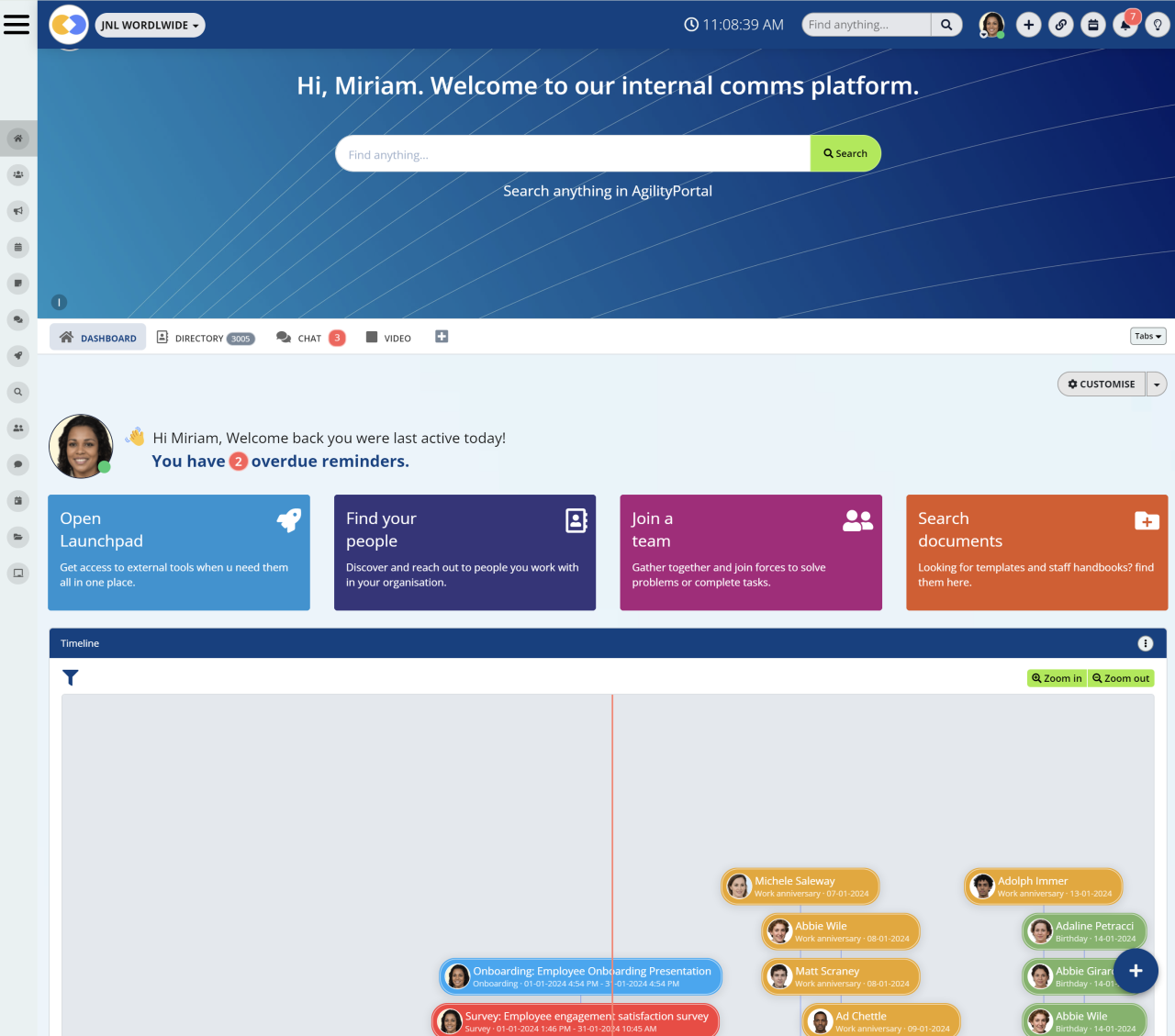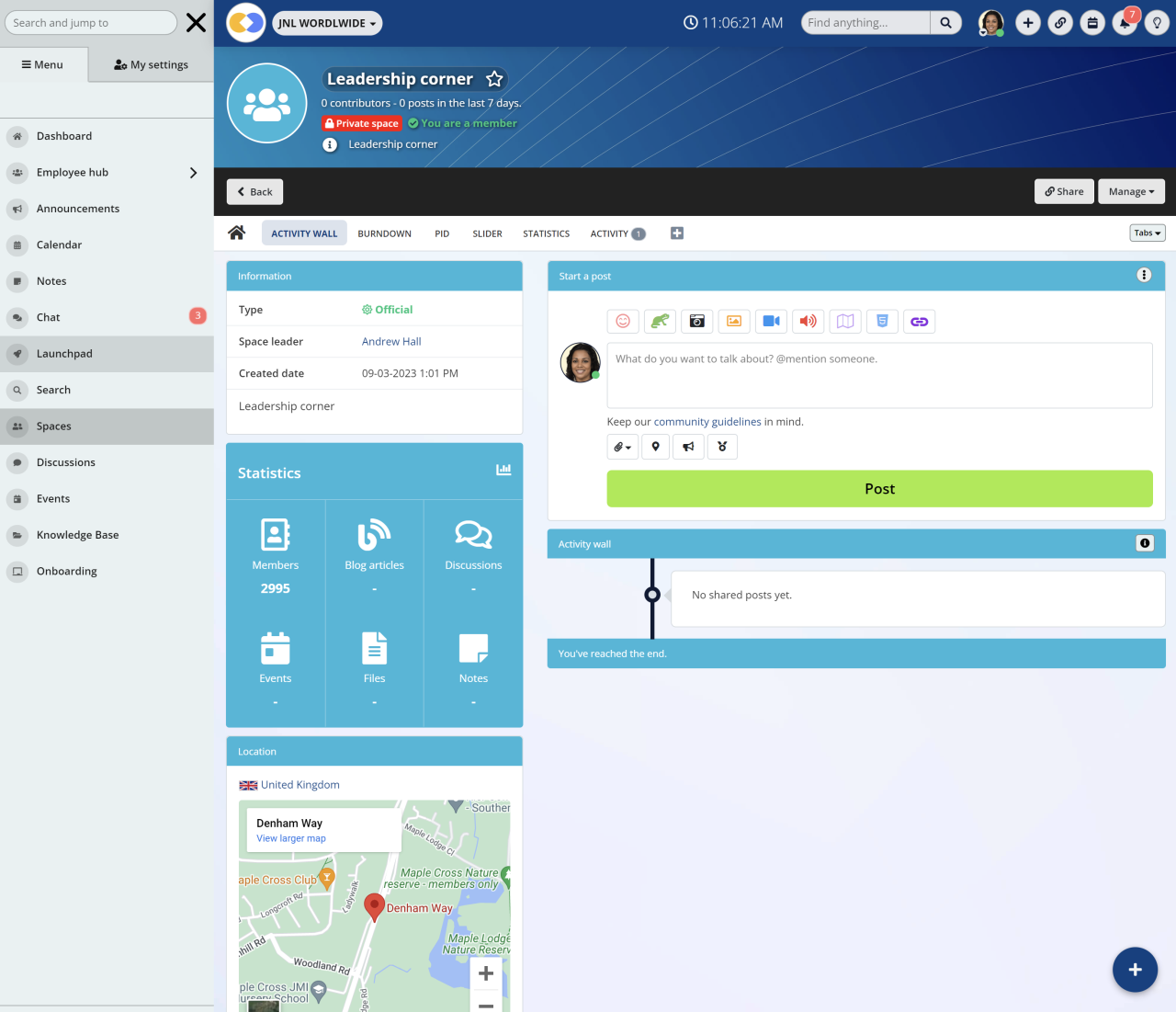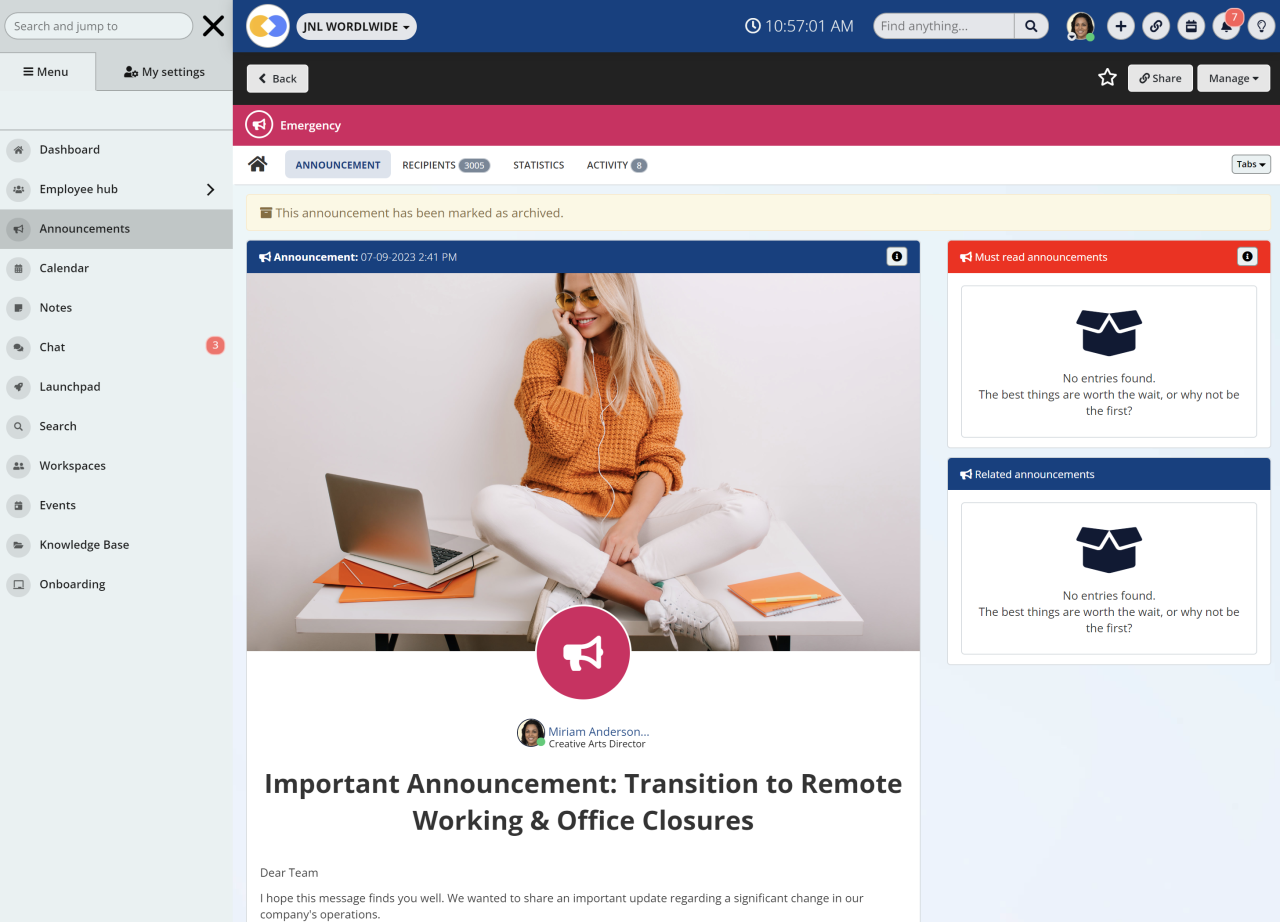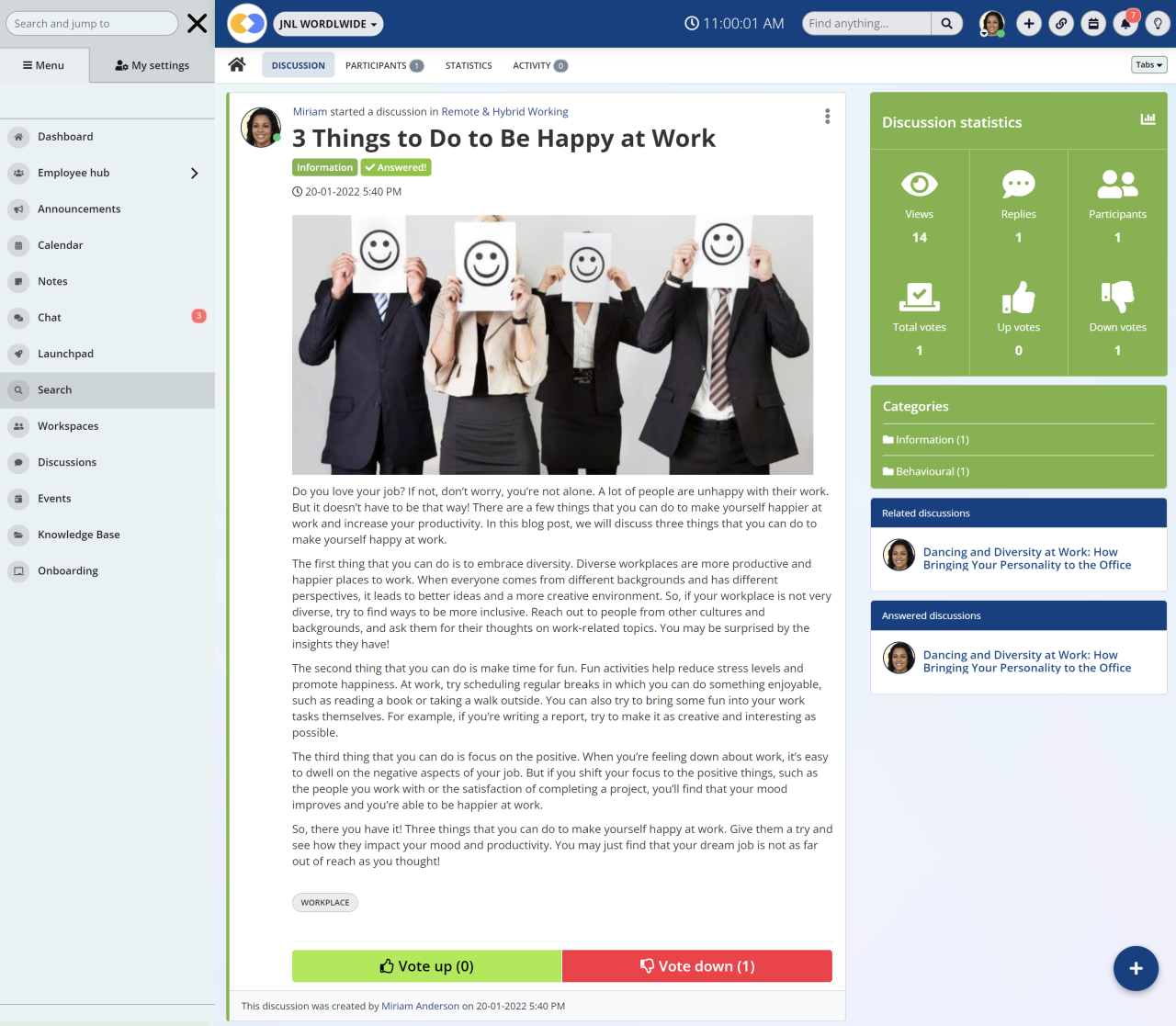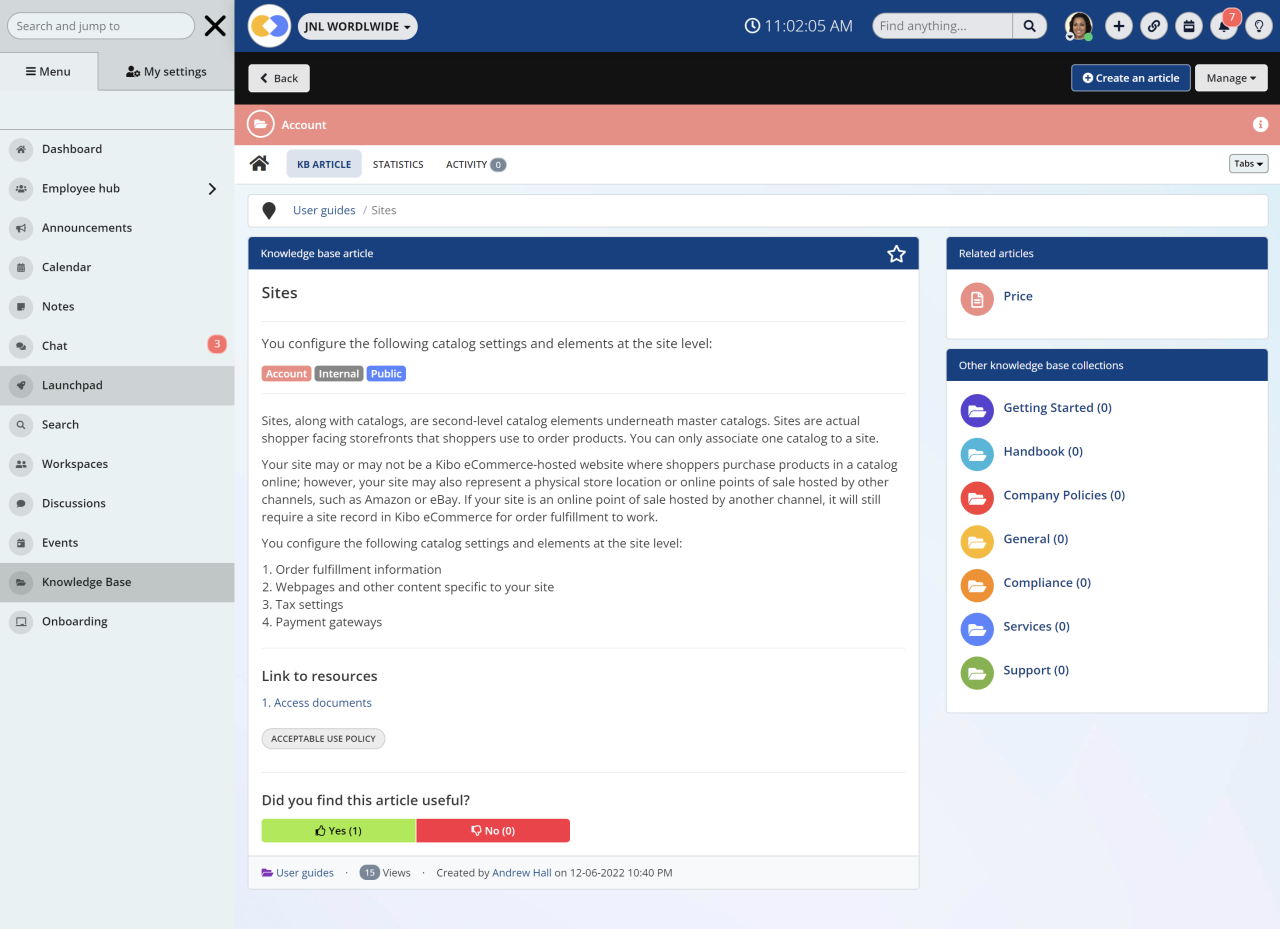Insight Blog
Agility’s perspectives on transforming the employee's experience throughout remote transformation using connected enterprise tools.
13 minutes reading time
(2629 words)
How to use your intranet for change management
How to use your intranet for change managemen. Learn how to make your change a success here.
In this blog we answer the question How to use your intranet for change management?
Perhaps you find yourself needing to embrace a new technology, respond to the emergence of a new competitor in your industry, or reshape your branding to appeal to a different customer base. It's possible that your organization, once centered around in-person interactions, now needs to cultivate a culture conducive to long-term remote work post-pandemic.
Alternatively, you might have originated as a small startup with just a few employees, and the time has come to adjust your systems, processes, and structure to align with your evolving status as a growing organization.
The undeniable truth is that change is a constant. Despite its frequent occurrence, navigating change can remain perplexing, stressful, and even intimidating for your employees. This emphasizes the importance of effective communication regarding change, ensuring that your workforce comprehends not only the what but also the why.
Continue reading for a comprehensive guide on managing change through internal communications, even if your Internal Communication function is not yet fully developed.
What is Change Management?
Communication in change management involves informing your employees and other stakeholders about alterations in the business and the reasons behind them.
Whether it's a shift in processes or upgrades in technology, changes often elicit concerns. Without a reliable, well-established internal communication system, employees may experience resistance or disengagement.
The significance of change management communication lies in the inherent human resistance to change, a trait observed throughout history. When organizational changes occur frequently, employees may feel fatigued and stressed, leading to decreased commitment to the organization.
As the rate of change increases, maintaining employee commitment to organizational change becomes increasingly challenging.
The statistics paint a concerning picture: 73% of employees affected by change report experiencing moderate to high stress levels, and those dealing with change-related stress perform 5% worse than their counterparts.
Effective change communication serves as a valuable tool to counteract these trends and bolster business transformation.
Therefore, effective change management communication is crucial to mitigate these negative effects and foster a smoother transition.
How does change management work?
Change management is a structured and strategic approach aimed at transitioning individuals, teams, and organizations from their current state to a desired future state.
The process involves a series of planned activities that help people embrace and adapt to changes in their work environment. One fundamental aspect of change management is understanding that change is not just about implementing new technologies or altering processes; it also encompasses the human side of transformation.
By acknowledging and addressing the emotional and psychological impact of change, organizations can enhance the likelihood of successful implementation.
The process typically begins with identifying the need for change, followed by defining the objectives and scope of the transformation.
A comprehensive change management plan is then developed, outlining the strategies, resources, and timelines required for a smooth transition. Communication plays a crucial role throughout the process, ensuring that all stakeholders are well-informed about the upcoming changes, the reasons behind them, and the benefits they will bring.
Engaging employees at every stage, from planning to execution, fosters a sense of ownership and commitment, reducing resistance and increasing the chances of successful implementation.
Change management also involves assessing and mitigating risks associated with the change, as well as providing the necessary training and support to help employees adapt to the new ways of working.
Monitoring and evaluating the progress of the change initiative is another integral component, allowing organizations to make adjustments as needed and ensure that the desired outcomes are achieved. It's crucial to recognize that change is a continuous process, and flexibility is key to adapting to unforeseen challenges or opportunities that may arise during the implementation.
Ultimately, effective change management is not a one-size-fits-all solution but a dynamic and tailored approach that considers the unique context and culture of the organization.
By prioritizing the human element, communicating transparently, and providing the necessary support, change management endeavors to create a positive environment where individuals and the organization as a whole can thrive amidst transformation.
Free eBook: Tracking Change Management: We will delve into ways to persuade others to make a change. It is because no two organizations or teams are identical. Thus, we have put together some pointers to help you make sure the changes you make stick.
Why Does Change Management Matter?
The impact of any organizational change, regardless of its scale, resonates with employees on various levels.
Neglecting the careful management of these changes poses the risk of adversely affecting employee productivity, efficiency, and, most importantly, their level of engagement.
Continuous and unmanaged changes can lead to a phenomenon known as change fatigue, which not only takes a toll on mental well-being but can also manifest as physical health implications.
The statistics are telling – a significant 73% of employees undergoing change report experiencing moderate to high stress levels. This heightened stress, in turn, correlates with a measurable 5% drop in performance.
Recognizing and addressing these challenges are paramount in developing a successful change management strategy.
The primary objective of any such strategy should be to proactively mitigate the risks associated with change, ensuring that employees are not only able to navigate the evolving landscape but also thrive within it.
Mitigating these risks involves a multifaceted approach.
First and foremost, effective communication is essential to keep employees well-informed about the nature of the changes, the reasons behind them, and the anticipated benefits.
This transparency not only reduces uncertainty but also fosters a sense of trust and inclusion among the workforce. Additionally, providing the necessary support mechanisms, including training and resources, aids employees in adapting to the new paradigm, minimizing the potential negative impact on their well-being.
In essence, a well-crafted change management strategy goes beyond merely implementing structural alterations; it prioritizes the human element, recognizing the importance of employee morale, satisfaction, and overall mental and physical health.
By actively addressing the challenges posed by change and offering robust support mechanisms, organizations can steer their workforce through successful business transformations, fostering a resilient and adaptable culture.
Follow us and access great exclusive content everyday: Follow us on Google News
You may also like: Best Apps for Employees: UPDATED 2022 – A Complete Guide
Transform your change communication plan with an intranet
Discover effective ways to harness the capabilities of your intranet or other digital workplace tools to facilitate smoother and more streamlined change communication processes within your organizational framework.
1.Unleash Change Awareness: Supercharge Your Intranet
Change communication needs ammo, and you'll be crafting a whole arsenal of materials: teasers, emails, infographics, manuals, podcasts, you name it. But where do you stash this content army? Look no further than your trusty intranet.
Think of it as the Fort Knox of your change campaign. It keeps all your assets under one roof, making it easy for employees to find what they need. Plus, if you're using Microsoft Viva, you can broadcast the same content across Engage and Connections. Consistent messaging, wider reach – everyone wins!
For major change initiatives, consider building a dedicated site within your intranet.
Now that's how you win a communication war!
Here's the gist:
- Intranet: Intranet change management - One-stop shop for all your change content.
- Microsoft Viva: Amplify your message across platforms.
- Dedicated change site: For bigger initiatives, go deeper.
- Asahi's success: Proof that a good intranet strategy can conquer change fatigue.
So, don't let your change content run wild. corral it in your intranet and watch your communication efforts thrive!
Bonus points:
- Highlight the benefits of an organized intranet for internal communication teams.
- Briefly mention other potential storage solutions and why the intranet reigns supreme.
- Add a call to action, encouraging readers to leverage their intranet for upcoming change initiatives.
Remember, it's not just about storing content, it's about unleashing its power to drive a successful change journey.
Free ebook: How To Get Your Intranet Off The Ground
2.Provide a Space for Leaders: Building Trust In Leadership
Establish a digital platform for executives to communicate their decisions and perspectives on the impending changes, expressing their enthusiasm for the anticipated positive outcomes.
Whether conveyed through blog posts or formal messages, leaders have the chance to directly address employees regarding the proposed changes, encouraging questions and comments.
This digital space serves as a valuable opportunity to showcase transparent communication, reinforce the company vision, and convey the leadership team's unwavering commitment to ensuring that the challenges posed by the changes are ultimately beneficial and worthwhile for all involved.
3.Unlocking Communication During Change: Announcement
In the absence of clear communication, employees tend to fill the void with rumors and misinformation, leading to increased resistance, anxiety, and diminished performance during organizational change.
To address this, centralizing all company announcements in a designated virtual town hall area proves crucial.
This ensures that employees have a comprehensive understanding of the changes, including precise details on when they will occur and how they will impact them.
To successfully implement this strategy, follow these steps:
- Designate a Virtual Town Hall Area: Set up a dedicated section within your digital communication platform, such as an intranet or collaboration tool, specifically designated as the virtual town hall area.
- Announcement Centralization: Channel all official company announcements related to changes, whether they involve processes, policies, or any other relevant information, through this virtual town hall. This centralization minimizes the risk of fragmented or inconsistent information circulating among employees.
- Timely Updates: Ensure that the virtual town hall is consistently updated with timely and accurate information. This proactive approach helps to stay ahead of potential misinformation and addresses concerns promptly.
- Accessibility and User-Friendly Interface: Make the virtual town hall easily accessible to all employees. Design the interface in a user-friendly manner, allowing individuals to quickly locate relevant information without unnecessary complexity.
- Interactive Features: Encourage interaction by incorporating features that allow employees to ask questions, provide comments, or engage in discussions within the virtual town hall. This fosters a sense of transparency and involvement.
- Regular Communication Schedule: Establish a regular schedule for posting updates and announcements. This consistency helps create a reliable source of information, reducing uncertainty and preventing the emergence of rumors.
- Promote Two-Way Communication: Actively encourage employees to seek clarification, ask questions, and share their concerns. This open dialogue helps in addressing any misconceptions promptly and reinforces a culture of transparent communication.
- Training and Familiarization: Provide training or informational sessions to familiarize employees with the virtual town hall platform. Ensure that everyone understands how to navigate the space effectively to access the information they need.
By following these steps, organizations can create a reliable and centralized communication hub, mitigating the risks associated with rumors and misinformation during times of change.
4.Provide a Space For Internal Communications: Discussions
Many change management communication strategies overlook the emotional impact that transitions can have on employees.
Failing to provide an avenue for employees to express their thoughts and feelings may result in them carrying these emotions home or resorting to unofficial channels and private conversations with colleagues.
To address this, establish forums that serve as outlets for employees to discuss their perspectives and emotions openly.
McKinsey research underscores the significance of such engagement during transitions, revealing that people are 30% more likely to embrace change when they feel genuinely invested. Importantly, resist the temptation to censor discontent.
Encouraging constructive criticism is more beneficial than suppressing it, as stifled dissatisfaction may resurface later as disengagement or even passive-aggressive behavior.
Follow these steps to implement an effective platform for open discussion:
- Identify Appropriate Platform: Determine the most suitable platforms or spaces within your organization where employees can openly discuss their thoughts and feelings. This could include digital forums, designated meeting spaces, or even anonymous suggestion boxes.
- Promote Accessibility: Ensure that the chosen forums are easily accessible to all employees. Utilize digital tools or physical locations that align with your workforce's preferences and work environment.
- Encourage Constructive Criticism: Establish a culture that values constructive criticism and encourages employees to express their concerns openly. Emphasize that providing feedback is essential for fostering a positive and collaborative work environment.
- Moderation and Guidance: Implement moderation strategies to ensure that discussions remain respectful and constructive. Provide guidance on the appropriate use of the forums and establish guidelines for communication.
- Regularly Monitor and Participate: Actively monitor the discussions within the forums and participate when necessary. This demonstrates leadership's commitment to transparency and willingness to address employee concerns.
- Feedback Integration: Create mechanisms to integrate valuable feedback received through these forums into the change management strategy. This ensures that employee perspectives contribute to the refinement and success of the transition process.
- Promote Inclusivity: Foster an inclusive environment where all employees, regardless of their role or level, feel comfortable expressing their thoughts. This inclusivity enhances the effectiveness of the discussion platform.
By incorporating these steps, organizations can establish a robust platform for open discussion, acknowledging the emotional aspects of change and promoting engagement during critical transition periods.
5.Provide a Space For Knowledge: Knowledge Base
To alleviate employee uncertainty, empower them with comprehensive information necessary not only to navigate the change process but also to excel in it.
Utilize the knowledge management capabilities of your platform to centralize fact sheets, backgrounders, e-learning materials, how-to videos, and other self-service resources in a unified location.
Follow these steps to effectively centralize critical knowledge:
- Identify Key Information: Determine the essential information relevant to the change process, including facts, guidelines, and instructional content that will aid employees in adapting to the changes.
- Leverage Knowledge Management Features: Utilize the knowledge management features of your platform to establish a dedicated repository for the identified information. This could involve creating folders, tags, or a searchable database to streamline access.
- Organize Content: Structure the content logically within the centralized repository. Categorize materials based on topics, stages of the change process, or any other relevant criteria to facilitate easy navigation.
- Incorporate Diverse Resources: Include a variety of resources such as fact sheets, backgrounders, e-learning modules, and instructional videos. This ensures that employees have diverse learning options to suit their preferences and needs.
- Ensure Accessibility: Guarantee that the centralized knowledge repository is easily accessible to all employees. Implement user-friendly interfaces and navigation tools to simplify the process of locating and retrieving information.
- Communicate the Resource Hub: Clearly communicate the existence and functionality of the centralized knowledge hub to employees. Provide instructions on how to access, navigate, and utilize the resources available.
- Facilitate Training: Offer training sessions or informational materials to guide employees on effectively using the platform's knowledge management features. Ensure that they understand how to leverage these resources for their benefit.
- Regularly Update Content: Keep the centralized repository up-to-date with the latest information. Regularly review and update content to align with any changes in the organizational landscape or additional insights gained during the change process.
- Monitor Usage and Gather Feedback: Track the usage of the centralized knowledge hub and gather feedback from employees. Use this information to refine and enhance the resource repository based on user experience and evolving needs.
By implementing these steps, organizations can establish a centralized repository of critical knowledge, providing employees with a comprehensive and easily accessible resource hub.
This proactive approach not only alleviates stress associated with information retrieval but also empowers employees to assimilate new information and progress effectively during the implementation of change.
Categories
Blog
(2600)
Business Management
(319)
Employee Engagement
(207)
Digital Transformation
(173)
Intranets
(119)
Growth
(118)
Remote Work
(61)
Sales
(48)
Collaboration
(37)
Culture
(29)
Project management
(29)
Customer Experience
(26)
Knowledge Management
(21)
Leadership
(20)
Comparisons
(5)
Ready to learn more? 👍
One platform to optimize, manage and track all of your teams. Your new digital workplace is a click away. 🚀
Free for 14 days, no credit card required.




